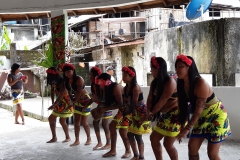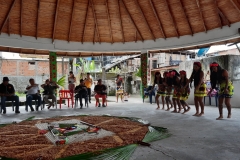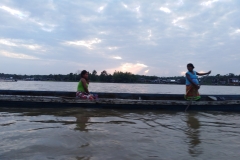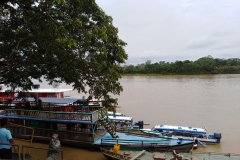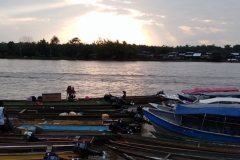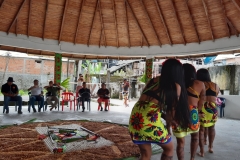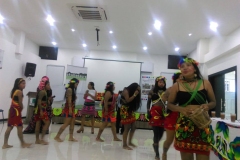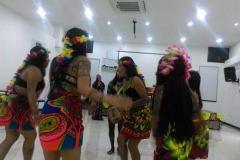The Emberá (people) People are made up of two groups: the Dobida (river people). The Eyábida (mountain people) are divided into the Katio and Chamí.
Geographically, they are “originally from the San Juan river region in bordering zones between the departments of Risaralda and Chocó, in the last decades they are located in 18 departments of the country, among these in isolated settlements (19) in the departments of Bolívar, Boyacá, Caquetá, Casanare, Meta, Santander and Tolima”. (Plan de Salvaguarda. MinInterior 2012, p.67). In addition to Colombia, there are some groups in Panama and Ecuador.
The Emberá resist the violence in their territories, which is why the Court tries to stop their physical and cultural extermination when it indicates that “due to its destructive consequences on the ethnic and cultural fabric of these groups, forced displacement generates a clear risk of extinction, cultural or physical, of indigenous peoples. Those who were already at risk prior to the impact of the armed conflict, are approaching the end; those who were not, enter the category of high risk of cultural and physical extinction.” (Auto 004 of 2009, p. 12)
Traditional painting
Body and face painting for indigenous peoples is an essential element of culture and cosmogony. It represents the vision of the world and is the plane where they connect with the natural world of the spirits. In the case of the Emberá, each line represents the plants, animals and the elements that take place in the cosmos.
The painting is the result of the fruit called Jagua or Kipara that is applied with thin wooden sticks, generally painting the upper part of the face from the eyebrows, but also the lower part, from the nose to the chin, this pigment is embedded in the skin and remains for approximately 15 days.
For the Dobida (River Embera), facial and body painting is usual for men and women, while for the Eyabida (Mountain Embera), only facial painting is usual, especially for women.
Body painting is done with geometric figures on the arms, legs, torso and back. According to the occasion, are the painted motifs: As they are in the ancestral rituals that are guided by a Jaibaná or also dances and traditional festivities.
According to the elders the Jagua is one of the most autochthonous artistic expressions, it also helps to:
Protect from evil spirits and diseases.
Give strength to babies and young people.
Communicate with the spirits.
Cure illnesses: stomach upset, skin conditions.
Identify oneself.
Beautify.
Express moods.
Body and face painting is an essential element of our culture and cosmogony. It represents our vision of the world and is the plane where we connect with the natural world of the spirits. For the Emberá each line represents the plants, animals and the elements that take place in the cosmos.
The black ink is obtained from the fruit called Jagua or Kipara and is applied with thin wooden sticks. The pigment is embedded in the skin and remains for at least 15 days. For the Emberá del Río (Dobida), facial and body painting is usual for men and women, while for the Eyabida (Emberá de Montaña), only facial painting is usual, especially for women.
The kipara is generally painted on the upper part of the face from the eyebrows, but also the lower part, from the nose to the chin. Body painting is done with geometric figures on the arms, legs, torso and back. According to the occasion, are the painted motives: As they are in the ancestral rituals that go with guide of a Jaibaná or also dances and traditional celebrations.
According to the elders, the Jagua is one of the most autochthonous artistic expressions, besides having different benefits.
Handicrafts: weavings of life
Crafts are the expression of the work of the people, of their customs, of the use they give to the instruments, therefore they surpass the object as a decorative element since they build their culture in the daily life of hunting, sowing, rituals.
Emberá Dobida: in their weavings they narrate the sowing, the harvest, the daily life in the territory, hence their strong colors. They weave baskets, pottery and necklaces in shakira while singing songs in their mother tongue.
Emberá Katío: their weavings are related to the jungle, the river and the animals, hence the yellow, the brown, the shades of green. The woman is the one who raises and takes care of the smaller species.
Emberá Chamí: their weavings are related to their native language, their cosmovision and spiritual world, as well as the constant communication they have with the jungle.
Dress
Indigenous knowledge and thought are symbolized in their forms of dress and, in that sense, are part of their own forms of communication.
Faces Indigenous Peoples
Face or body painting is part of the identity of the Emberá Dobida and Eyabida (Katío and Chamí), Nukak and Barí peoples, but it is also their way of expressing cosmogony, the spiritual and the earthly.
Emberá Dobida: From their cosmovision, the faces transmit wisdom, energy, strength and fortitude. Their paintings, on their bodies, communicate the collectivity.
Emberá Katío (Eyabida): men and women manifest themselves through their painting, with it they strengthen the collective life, thinking, feeling, acting, according to the cycles of the environment where they are.
Emberá Chamí (Eyabida): in their faces symbols of protection, security, strength for their life and their people.
Gastronomy
They live by the water, that is why they take special care of the rivers, which are their main source of food. In those semi-nomadic peoples, the “pan coger” gardens are also part of the diet of these communities.
Emberá Dobida and Chamí: the way they take care of their original world is through gathering, hunting, fishing, and agriculture, what they grow the most is corn and bananas.
Emberá Chamí: fishing and hunting is their permanent activity and the basis of agriculture is coffee, cocoa, chontaduro, corn, beans, sugar cane.
Landscape – Territory
The landscape is the territory of the indigenous peoples and communities. It is their chagras (crops), dwellings, but also the mountains, jungles and rivers.
Music
The Emberá music shows the ancestral traditions with the use of different instruments of great importance, besides rescuing the musical influence of other cultures of Colombia.





